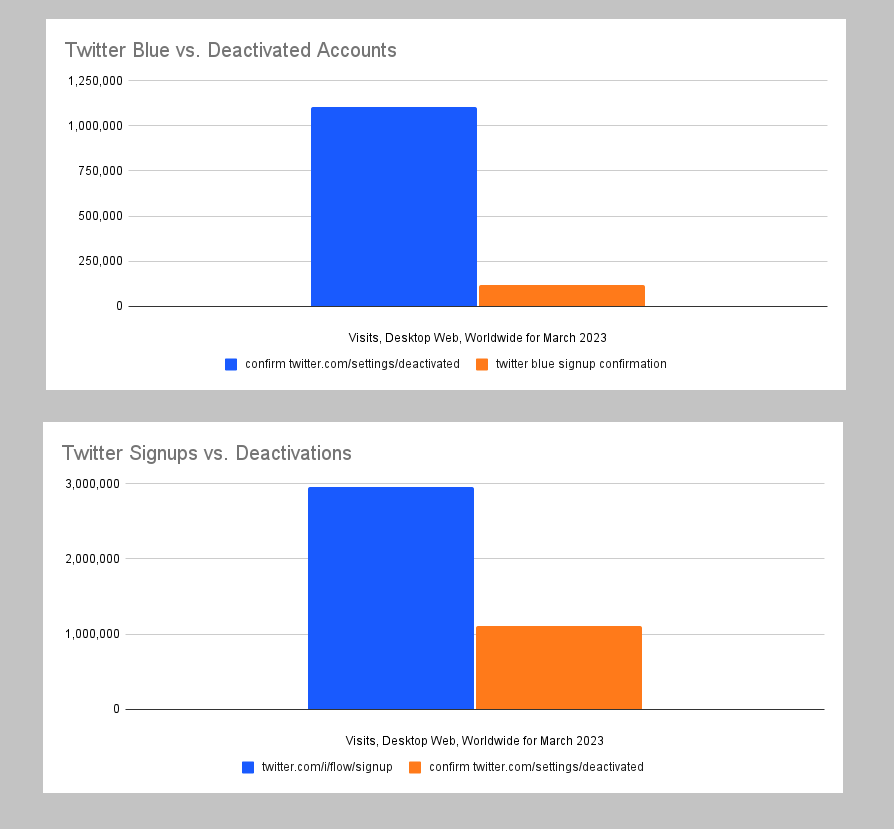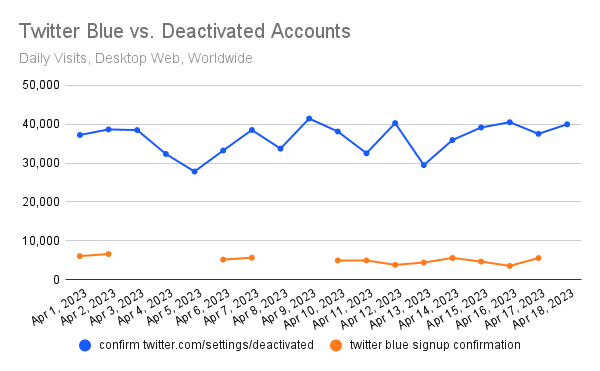Twitter is an app that seems to be making the headlines every now and then.
Sometimes it’s linked to its wide array of features but on most other occasions, it has to do with Elon Musk's erratic decision-making. But new research is signaling alarm bells for the popular microblogging website, thanks to new stats achieved in this regard.
As the platform’s Legacy blue ticks are leaving the app today, the change might be doing more damage than good for the company. New data proves how more and more people are willing to deactivate their accounts instead of actually paying $8 to receive a blue subscription.
The famous blue checkmark used to be perceived as a status symbol that could not be purchased. But it does represent verification and it gave users of the platform a sense of security that all was well and they weren’t dealing with an impersonator. But now that it’s slowly dwindling away, there is a major problem. And that is how people could care less.
Musk always assumed putting Blue Ticks for sale would make people feel threatened and would resort to buying a subscription. But that’s far from reality. The data from Similarweb hints at how only 6,600 people took on the paid signup feature while 38,700 users preferred to deactivate the account in time for the deadline.
So in reality, people are 6 to 10 times more likely to axe their accounts instead of actually upgrading them.
Last month, around 1.1 million users of the app said farewell to their accounts by deactivation when compared to the staggering 116,000 who confirmed signing up for the subscription.
Then Twitter did attract 3 million visits to the new account signups page last month, the research adds. So when you look at it, signups that are getting offered for free outnumber the deactivation by almost 3 to 1.
Then we witnessed account deactivations which were at an all-time high for the tech billionaire’s app after he chose to take charge. But since then, it has come down, being just 37,000 a day last month. But during the start of 2023, the app’s engagement really did fall significantly YoY.
The world’s second richest person says that his app is really making the most of people spending most of their time on the platform. But we just are not seeing that.
Parts of a newly published BBC interview showed Musk boasting about engagement figures and its breaking records and how so many advertisers were coming back. But it’s just so interesting that we aren’t seeing this arise in real-time.
Thanks to estimates from SimilarWeb, we’re not seeing that and in fact, we are seeing the extreme opposite. The monthly report regarding traffic on the platform’s ad portals witnessed a startling 18.7% YoY decline for the app in the month of March.
And from what we’re witnessing with time, the app’s usage continues to fall since the start of 2023. In fact, global visits to the platform fell by 7.3% YoY in the month of March. And this happens to be the third consecutive month of the ordeal.
Then we witnessed the app’s unique visitor count falling by 3.3% YoY last month too.
As far as the app’s Android version is concerned, we saw a 9.8% drop in the figure for daily active users and the number of monthly active users also fell 8% YoY. Furthermore, in the US, we saw the figure for monthly active users on the app decline by 15% on iOS devices and 14% through Android.
Read next: According to recent survey Twitter is seeing a massive exodus of journalists
Sometimes it’s linked to its wide array of features but on most other occasions, it has to do with Elon Musk's erratic decision-making. But new research is signaling alarm bells for the popular microblogging website, thanks to new stats achieved in this regard.
As the platform’s Legacy blue ticks are leaving the app today, the change might be doing more damage than good for the company. New data proves how more and more people are willing to deactivate their accounts instead of actually paying $8 to receive a blue subscription.
The famous blue checkmark used to be perceived as a status symbol that could not be purchased. But it does represent verification and it gave users of the platform a sense of security that all was well and they weren’t dealing with an impersonator. But now that it’s slowly dwindling away, there is a major problem. And that is how people could care less.
Musk always assumed putting Blue Ticks for sale would make people feel threatened and would resort to buying a subscription. But that’s far from reality. The data from Similarweb hints at how only 6,600 people took on the paid signup feature while 38,700 users preferred to deactivate the account in time for the deadline.
So in reality, people are 6 to 10 times more likely to axe their accounts instead of actually upgrading them.
Last month, around 1.1 million users of the app said farewell to their accounts by deactivation when compared to the staggering 116,000 who confirmed signing up for the subscription.
Then Twitter did attract 3 million visits to the new account signups page last month, the research adds. So when you look at it, signups that are getting offered for free outnumber the deactivation by almost 3 to 1.
Then we witnessed account deactivations which were at an all-time high for the tech billionaire’s app after he chose to take charge. But since then, it has come down, being just 37,000 a day last month. But during the start of 2023, the app’s engagement really did fall significantly YoY.
The world’s second richest person says that his app is really making the most of people spending most of their time on the platform. But we just are not seeing that.
Parts of a newly published BBC interview showed Musk boasting about engagement figures and its breaking records and how so many advertisers were coming back. But it’s just so interesting that we aren’t seeing this arise in real-time.
Thanks to estimates from SimilarWeb, we’re not seeing that and in fact, we are seeing the extreme opposite. The monthly report regarding traffic on the platform’s ad portals witnessed a startling 18.7% YoY decline for the app in the month of March.
And from what we’re witnessing with time, the app’s usage continues to fall since the start of 2023. In fact, global visits to the platform fell by 7.3% YoY in the month of March. And this happens to be the third consecutive month of the ordeal.
Then we witnessed the app’s unique visitor count falling by 3.3% YoY last month too.
As far as the app’s Android version is concerned, we saw a 9.8% drop in the figure for daily active users and the number of monthly active users also fell 8% YoY. Furthermore, in the US, we saw the figure for monthly active users on the app decline by 15% on iOS devices and 14% through Android.
Read next: According to recent survey Twitter is seeing a massive exodus of journalists






